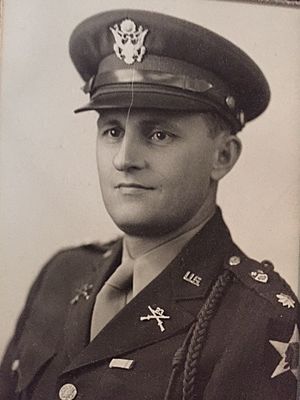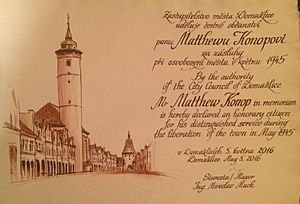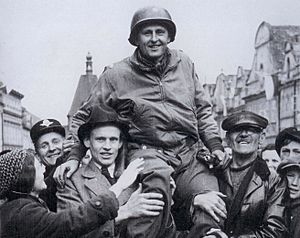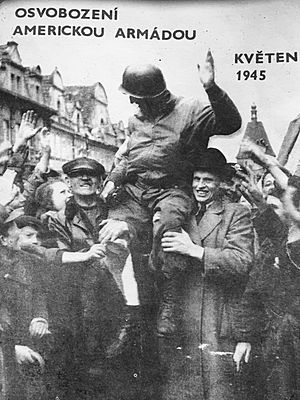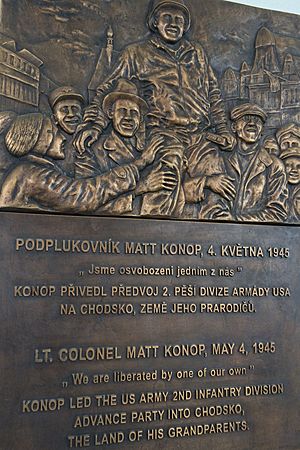Matt Konop facts for kids
Matt Konop (born February 6, 1906 – died May 12, 1983) was a brave officer in the United States Army during World War II. He is famous for his role in the Battle of the Bulge. He is also celebrated in the Czech Republic for helping to free the cities of Domažlice and Pilsen in Czechoslovakia at the end of the war.
In May 1945, Konop was chosen to lead a special group from the 2nd Infantry Division. General Walter M. Robertson, the division's commander, learned that Konop spoke Czech and had family roots there. By chance, Konop's group helped free the very same Czech villages where his grandparents had lived before moving to America. As news spread, people were thrilled that "one of their own" had returned to free them from six years of rule by Nazi Germany.
Today, you can see a bronze plaque of Matt Konop on the Hruska building in the main square of Domažlice, in the Czech Republic. This is where he parked his jeep on May 4, 1945, and was welcomed as a hero. In 2016, Konop was made an honorary citizen of Domažlice.
Contents
Early Life
Matt Konop was born in Stangelville, Wisconsin. This town is about twenty miles southeast of Green Bay. His grandparents were farmers who moved to Wisconsin in the late 1860s. They came from the Chodsko region in southern Bohemia, which is now part of the Czech Republic.
They joined other Czech immigrants in an area with many different European families. These families were turning the forests of northeastern Wisconsin into dairy farms. Matt Konop grew up speaking Czech on the family farm. He was the oldest of 11 children. He finished Kewaunee High School in 1924.
World War II Service
In late 1940, Matt Konop received a letter from the U.S. Army. It strongly suggested he join the army full-time as an officer. Konop joined and moved with his wife and three young children to Fort Sam Houston in San Antonio, Texas.
He started as a captain in the 2nd Infantry Division. By the time he landed on Omaha Beach on June 7, 1944, the day after D-Day, he had been promoted to lieutenant colonel. He was in charge of Special Troops and the main Command Post for his division throughout the war.
The Battle of the Bulge
On the morning of December 17, 1944, Konop led a small group of soldiers. This group included cooks, jeep drivers, and military police. Their job was to defend the command post in Wirtzfeld, Belgium. A German SS Panzer Tank group was attacking.
This was the start of Germany's huge surprise attack, known as the Battle of the Bulge. The 2nd Infantry Division's command post was almost unprotected. Konop's notes from the day before showed that they thought the German tanks were just a small local attack. They did not realize it was a major part of a huge offensive.
Germany's goal was to break through the American lines to the Meuse River. Then they wanted to reach the port city of Antwerp, Belgium. This would separate the Allied armies and reverse months of German losses. General Walter E. Lauer said about the battle for Wirtzfeld, "The enemy had the keys to success in its hand but didn’t realize it." At one point, German tanks were very close to the command post. For his bravery during this battle, Konop received the Bronze Star medal.
Liberating Czechoslovakia
On April 30, 1945, the 2nd Infantry Division moved under General George S. Patton’s Third Army. Their mission was to free southern Czechoslovakia. When General Robertson, the division commander, found out Konop could speak Czech, he gave him a special job. Konop was to lead the division's first group into the country.
On May 2, Konop and his jeep driver entered Czechoslovakia. They arrived in the village of Klenci. This village happened to be where Konop's maternal grandmother used to live. In the town, they found a secret meeting of local resistance fighters. Konop told the Czechs, in their own language, that his division was coming to free their country.
The men cheered with joy. They were amazed that the first U.S. Army officer to tell them they were free spoke their language. His last name was also common in the area.
By the time Konop made camp that night, news had spread. People in the area heard they had been "liberated by one of our own." Two days later, on May 4, Konop entered the city of Domazlice. He saw banners in the main square welcoming him as their liberator. As people celebrated the end of six years of Nazi rule, a group recognized Konop. They lifted him onto their shoulders and carried him around the main square. He was a hero who had returned to free his people.
Domazlice was officially freed on May 5. Similar celebrations happened in other parts of Czechoslovakia freed by the Americans. Czech and American flags were raised together. Citizens wore their traditional clothes to greet the troops.
On May 6, the division set up its command post in Pilsen, their final stop of the war. The city was safe, and the 2nd Infantry Division was in the center of town. On May 7, General Robertson hosted a party. He invited city officials, artists, and other guests to celebrate with his team. Since Konop spoke both English and Czech, he was the Master of Ceremonies. At midnight, he announced over the town's loudspeakers that the war in Europe was over. A huge celebration followed in the square.
Matt Konop's Legacy
After the war, in the fall of 1945, Konop returned to his family in Two Rivers, Wisconsin. He sold insurance and stayed in the Army Reserves. He and his wife had four more children. Konop visited Czechoslovakia twice, in 1975 and 1979. At that time, the Czechs were under Soviet rule. On his last trip, he spent several days in the Domazlice region. He spoke with people in Czech about the American liberation in 1945.
After the fall of the Berlin Wall in 1989, the Museum of Domazlice published a pamphlet in 1990. It celebrated the country's new freedom and the American Army's role in World War II. The cover of the pamphlet shows a picture of Colonel Konop on the shoulders of the people of Domazlice in May 1945.
The Accidental Hero Play
Twenty years after Matt Konop's death, his family found his writings about his time in the war. They were in a family member's basement. Konop's grandson, Patrick Dewane, turned these writings into a one-man play called The Accidental Hero. He also included his grandfather's old film footage from World War II and war souvenirs.
In the play, Dewane plays many different characters, including Konop himself. He shares the amazing coincidences in Konop's war service. He also shows how astonished the people of Czechoslovakia were, and still are, about the Czech-speaking American hero who returned to help free them from the Nazis.
Since 2010, The Accidental Hero has been performed in over 100 places across the United States. Since 2012, Patrick Dewane visits the Czech Republic every May. He performs the play with Czech subtitles in cities like Prague, Pilsen, and Domazlice. These performances often happen during annual celebrations of the American Army's liberation. People in these towns drive American World War II vehicles and wear old Army uniforms.
Bronze Plaque Dedication
On May 5, 2015, a bronze plaque was placed on the Hruska building in Domazlice's main square. It shows the famous photo of Konop on the shoulders of the townspeople. The plaque celebrates Matt Konop's role in bringing freedom to the area. The words on the plaque are in both Czech and English. In the picture, Konop is holding his Kodak movie camera.


